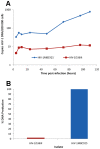High viral fitness during acute HIV-1 infection
- PMID: 20844589
- PMCID: PMC2936565
- DOI: 10.1371/journal.pone.0012631
High viral fitness during acute HIV-1 infection
Abstract
Several clinical studies have shown that, relative to disease progression, HIV-1 isolates that are less fit are also less pathogenic. The aim of the present study was to investigate the relationship between viral fitness and control of viral load (VL) in acute and early HIV-1 infection. Samples were obtained from subjects participating in two clinical studies. In the PULSE study, antiretroviral therapy (ART) was initiated before, or no later than six months following seroconversion. Subjects then underwent multiple structured treatment interruptions (STIs). The PHAEDRA study enrolled and monitored a cohort of individuals with documented evidence of primary infection. The subset chosen were individuals identified no later than 12 months following seroconversion to HIV-1, who were not receiving ART. The relative fitness of primary isolates obtained from study participants was investigated ex vivo. Viral DNA production was quantified using a novel real time PCR assay. Following intermittent ART, the fitness of isolates obtained from 5 of 6 PULSE subjects decreased over time. In contrast, in the absence of ART the fitness of paired isolates obtained from 7 of 9 PHAEDRA subjects increased over time. However, viral fitness did not correlate with plasma VL. Most unexpected was the high relative fitness of isolates obtained at Baseline from PULSE subjects, before initiating ART. It is widely thought that the fitness of strains present during the acute phase is low relative to strains present during chronic HIV-1 infection, due to the bottleneck imposed upon transmission. The results of this study provide evidence that the relative fitness of strains present during acute HIV-1 infection may be higher than previously thought. Furthermore, that viral fitness may represent an important clinical parameter to be considered when deciding whether to initiate ART during early HIV-1 infection.
Conflict of interest statement
Figures










References
-
- Tebit DM, Nankya I, Arts EJ, Gao Y. HIV diversity, recombination and disease progression: how does fitness “fit” into the puzzle? AIDS Rev. 2007;9:75–87. - PubMed
-
- Chun TW, Carruth L, Finzi D, Shen X, DiGiuseppe JA, et al. Quantification of latent tissue reservoirs and total body viral load in HIV-1 infection. Nature. 1997;387:183–188. - PubMed
-
- Ho DD, Neumann AU, Perelson AS, Chen W, Leonard JM, et al. Rapid turnover of plasma virions and CD4 lymphocytes in HIV-1 infection. Nature. 1995;373:123–126. - PubMed
-
- Perelson AS, Neumann AU, Markowitz M, Leonard JM, Ho DD. HIV-1 dynamics in vivo: virion clearance rate, infected cell life-span, and viral generation time. Science. 1996;271:1582–1586. - PubMed
Publication types
MeSH terms
Substances
LinkOut - more resources
Full Text Sources
Medical

